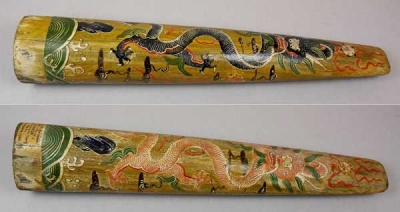Wooden sheath (1926.33.3)
 ChinaWooden sheath from China, Asia. Owned by Harry Geoffrey Beasley. Given to the Museum in 1926.
ChinaWooden sheath from China, Asia. Owned by Harry Geoffrey Beasley. Given to the Museum in 1926.
Here we see the two sides of a wooden sheath for spear-head, painted with dragons, black on side and red on the other. Although the documentation suggests this object may have come from Tibet, the bright painted decoration is much more of the style of the ruling Manchu/Qing dynasty in China (1644-1912). It probably dates to the 18th or 19th century when spears were reserved for the strongest and most daring soldiers. Typically, Chinese spears were always sheathed to protect them but leather hoods were commoner than wooden examples such as this.
The Manchu style of court art - seen in architecture, furniture, textiles and painting - was rather archaic, taking its inspiration from the iconography of the Warring States (481-206 BC) and Han (206 BC-221 AD) periods. Ancient Taoist motifs such as dragons, scroll-clouds and plants were used. The dragon was hugely important, signifying Yang, the masculine, active and fertile half of the two major governing forces of the universe itself. This sheath depicts a pair of five-clawed dragons emerging from the sea. Paired dragons were one of the 12 imperial symbols of the Qing emperor, and their five claws indicate a most auspicious and highly Imperially-ranked owner.




